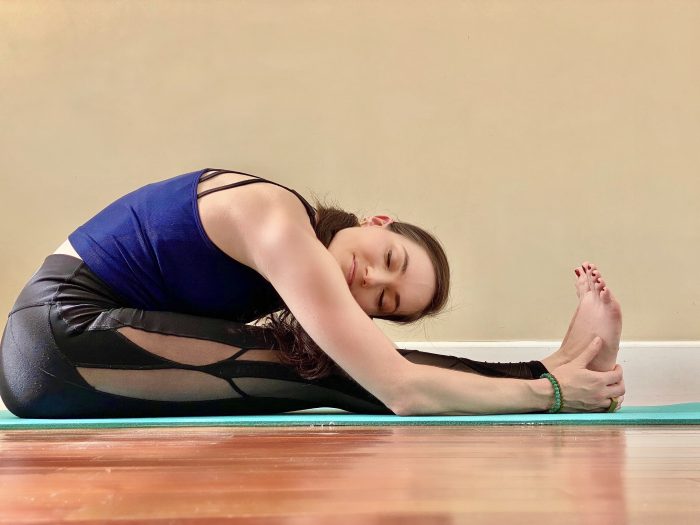The entire yoga community was introduced to some pretty massive shifts in 2020.
As we head into 2021, it’s safe to say that many of our new fitness routines will remain in the comfort of our homes (at least for now).
While gathering in studio settings and outdoor spaces to practice together was once the norm, it has now transformed to mostly virtual connections at our home base. No doubt we’re all missing that real-life human connection and the special energy found in communal practice.
One silver lining from this change? Shelter in place has introduced some practitioners to their very own home yoga practice! For some camps of yogis, this is a big win.
Before, it possibly felt like a stretch to incorporate a practice outside of the studio setting and without the company of friends. This radical change to our fitness routines has naturally encouraged us to go deeper into our personal experiences. And how better than to practice in the sanctuary of our most intimate environments, home sweet home.
Nevertheless, this virtual migration has been a surprising success and one that deserves a lot of credit for both teachers and students alike. No matter what side of the screen we’ve been on, we’ve all demonstrated an impressive amount of patience, flexibility, and innovation in the process. Some may even reason that they prefer to practice remotely for various reasons.
But now that we’ve had some time to adjust to this shelter-in-place as the new normal (for the foreseeable future), what comes next for our yoga from home lifestyle?
A true home yoga practice is much more than clicking a Zoom link and tuning in for a 60-minute class with a bunch of yoga strangers.
We’re now getting used to unrolling our mats in a special corner of our homes, getting acclimated to our own environments, and sprucing up our chosen spaces to attain that zen studio feel. A genuine home practice is beyond the literal sense of merely practicing at home. It requires a bit of disconnect from the external, community setting. The authentic “home practice” provides yogis with the chance to dive deeper into their own personal practice, without the influence or instruction from others.
So here’s where we find an interesting opportunity to incorporate both worlds: the benefit of still practicing in community with the benefit of practicing alone and guiding our own personalized experience. And when we can honor both formats, the prime takeaway is a theme that yoga teaches very well: balance.
If the only time we are practicing yoga is through virtual yoga classes, we’re really missing out on a special opportunity. An opportunity where we can truly learn from this interesting time in history. And that deeper spiritual growth can inevitably come from a solitary, at-home practice.
Being a teacher myself, in no way am I telling you to stop your community practices with your favorite teachers. On the contrary, keep supporting the yoga community, show up in support for your fellow yogi, and embrace that special sense of spiritual belonging and connection. But, also, support yourself from some breaks away from the computer screen now and again. Especially now, when so much has fully transitioned to a virtual landscape, we have to be extra cognizant of prolonged screen time usage.
Jack Kornfield elegantly wrote: “When we are faced with a variety of spiritual teachings and practices, we must keep a genuine sense of inquiry. What is the effect of these teachings and practices on myself and others? In his last words, the Buddha said we must be a lamp unto ourselves.” [Kornfield, J. (1993). A Path with Heart: A Guide Through the Perils and Promises of Spiritual Life, New York, NY: Bantam Books]
We should embrace our yoga practice for both the internal and external aspects while first taking refuge in our own experience. In the current times, there’s an overload of information and events that are being thrown into our view at a rapid pace. It is much more critical to take steps closer toward our inner world rather than away from it. That isn’t to say that we can’t gain personal benefits from a group class. But if we solely rely on these social contexts, we are responding to external influences rather than our own personal insights.
To distill this in a way that feels feasible and accessible to all levels of practitioners, I’ve come up with some tips to balance your communal and individual home practice:
1. After each virtual group class, jot down a few poses or sequences that you particularly liked.
When we write, we can more easily retain. For those of us who aren’t already yoga teachers and may not know the first steps to developing yoga sequences, this is one area where you can really have fun and learn. However, try not to take notes during your actual group practice. The ideal is that you can stay connected to your practice as it is happening. After class, when you take note of the sequences and poses that felt most nourishing in your body, this further supports the purpose of a home practice. Your home practice is designed to support you personally and your body’s needs.
2. Start small and build from there.
If developing a solo home practice is a new adventure for you, my best advice is to start small and build from there. You are not expected on the first round to nail all of the logistics. The first few times, month, and so on, may feel a little start and stop. So to make the most out of your time and keep it focused, start practicing in small increments.
This could be as simple as a short 15-minute stretch or meditation. Commit to those 15 minutes and seek to remove yourself from any external distractions (as best as possible). Once you start finding your groove, work your way up to 30, 45, and eventually a 60-minute class. Everyone is different in their journey, so you may hit those numbers earlier or later. But the key is mastering an adequate level of focus and commitment in those time pockets so your foundation can sustain from that point forward.
3. Try prioritizing your personal home practice before your group yoga classes.
Assuming that it may feel easier to click a button to attend an online class, rather, try to start off each week with your solo, home practice. This could be Sunday or Monday, whatever time of day works best for you. The freedom of practicing on your own watch can also feel liberating. You know you best, so you can pick and choose what time of day you like to practice. When you prioritize your home practice first, that commitment is a quick win. And the next time you show up to your group practice, it may be with a little more presence and attention.
4. Schedule your solo practice in your calendar.
Because many of us are putting the pause on commuting, we suddenly have these extra time pockets in our day. I think we all can agree that the added free time is much appreciated, but it is also additional time to manage. Try to approach your home practice like work and/or regular engagement with those close to you. We schedule commitments that are important, so treat your home practice as such. Once you find the time and days that work best for you, throw those time blocks on the calendar and plan accordingly.
5. Get creative with it.
Sometimes we need an extra jolt of inspiration to get us to the mat, so find out what that could be for you. You could create your own themes each week, bring in favorite quotes, incorporate essential oils, or craft authentically curated playlists. Whatever those motivating sources are, let them fuel you with excitement and creativity.
6. Get to know the “Tapas” Niyama well: discipline, discipline, discipline.
In Pantanjali’s Eight-Limbed Path, the Niyamas are seen as observances. Basically, they are guidelines to help yogis develop their inner worlds. Tapas translates to “heat” or “burn” in Sanskrit, signifying how commitment leads to transformation. It is important to have compassion in understanding that starting a home practice isn’t easy. Some days you simply will want to bail out because you don’t have anyone else holding you accountable. But as all of us want reliable friends, partners, and community in our lives, try to uphold reliability to yourself.
It is natural that there will be times where we avoid, dread, or simply just aren’t in the mood to practice. Know that those initial hesitations will be fleeting and you have the willpower to follow through. And when there are days when you are sick or really intuitively know that you shouldn’t practice, that is also practice in and of itself. Self-caring in the way you need, when you need it, is a further reflection of your inner teacher emerging.
On the days when your body isn’t fit to physically practice, still try to incorporate self-discipline. You can replace asana with an interesting read or dive into some aspects of yoga philosophy instead. Bottom line, get used to being your own coach and make it to the mat when you can.
7. Identify what is most challenging and rewarding about your home practice and let it be a meditation.
As your home practice evolves, so do you, and so does your relationship to your sacred time. Keep an open mind and heart as you explore the various layers that come up in the journey. One helpful technique that I’ve developed in my own home practice is being mindful of what is most challenging and rewarding in my home practice.
At the start of a home practice, it can be much easier to identify why it is challenging to make it to your mat. Acknowledge whatever comes up, but then let it pass. Transform that energy in a way where it starts to become a clearing ritual. Then at the end of practice, reflect and feel into the beneficial results of your practice. Sometimes these inquiries are small and simple, and sometimes they are more profound. Either way, learn from your own habits and blockers and continue to learn how the practice supports you.
In this interesting time to be alive, we are all still learning so many new things, whether consciously or unconsciously.
If you’ve gotten to this point in my article, I hope you are curious about the fulfilling rewards of a screen-less, solo home practice. Keep attending those virtual, group yoga classes, but maybe see what it feels like to steer and navigate your own experience as well. And if you are already attending online classes, you have enough tools to start—you got this.
As I mentioned before, approach these unique times as a free gift and opportunity to dig a little deeper. Get to better understand your own body, mind, and heart by being your own leader and teacher. A solo home practice will give you the space to really evolve.
You will learn more about yourself. You will be more apt to honor your needs. You will build more self-compassion and confidence. You will tune into your unique creativity. Your intuition will increasingly develop. You will call forward your innate, inner teacher.
The experience will look different from person to person, but there are always gains from a personal, home practice.
Look forward to the journey, happy virtual and non-virtual home practice to you!
~









Read 17 comments and reply